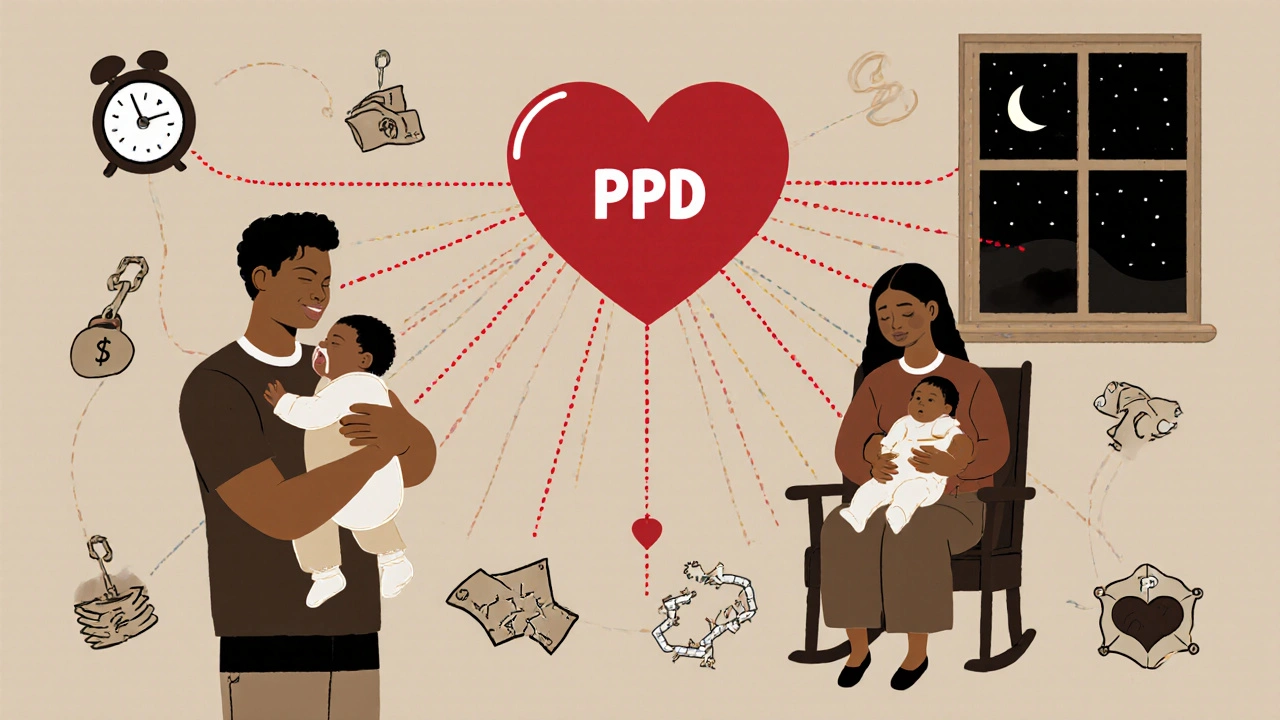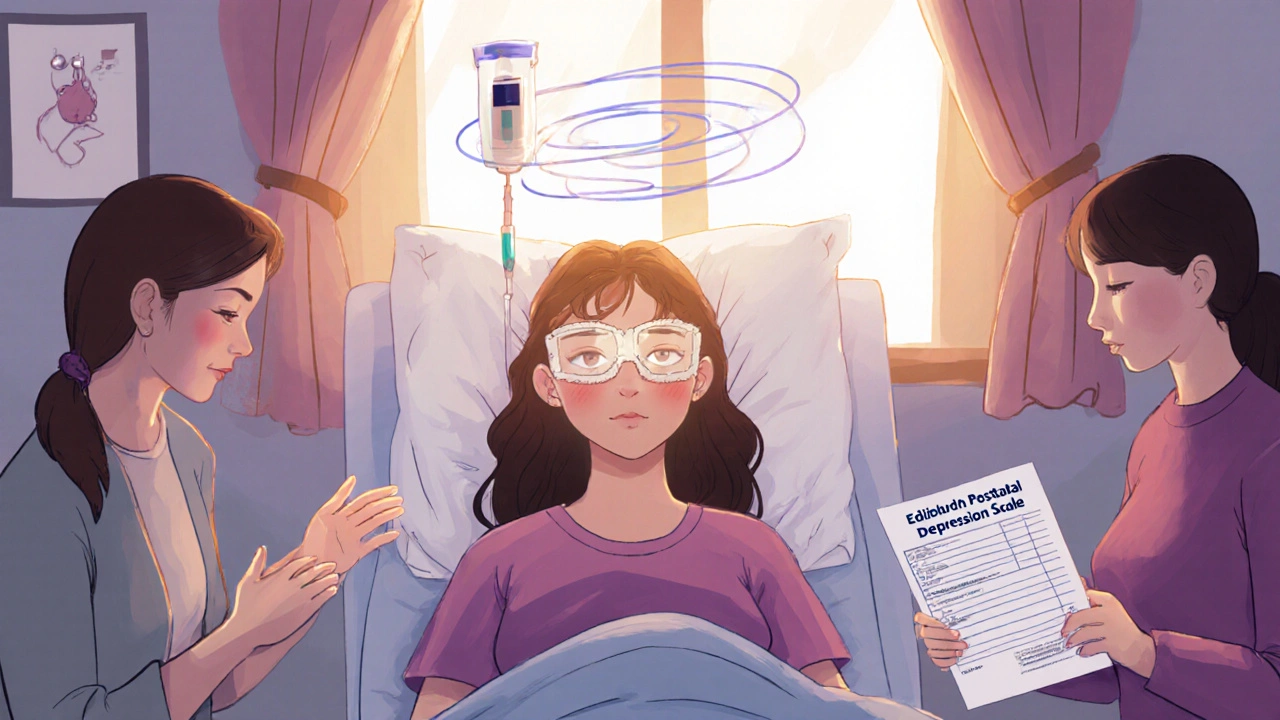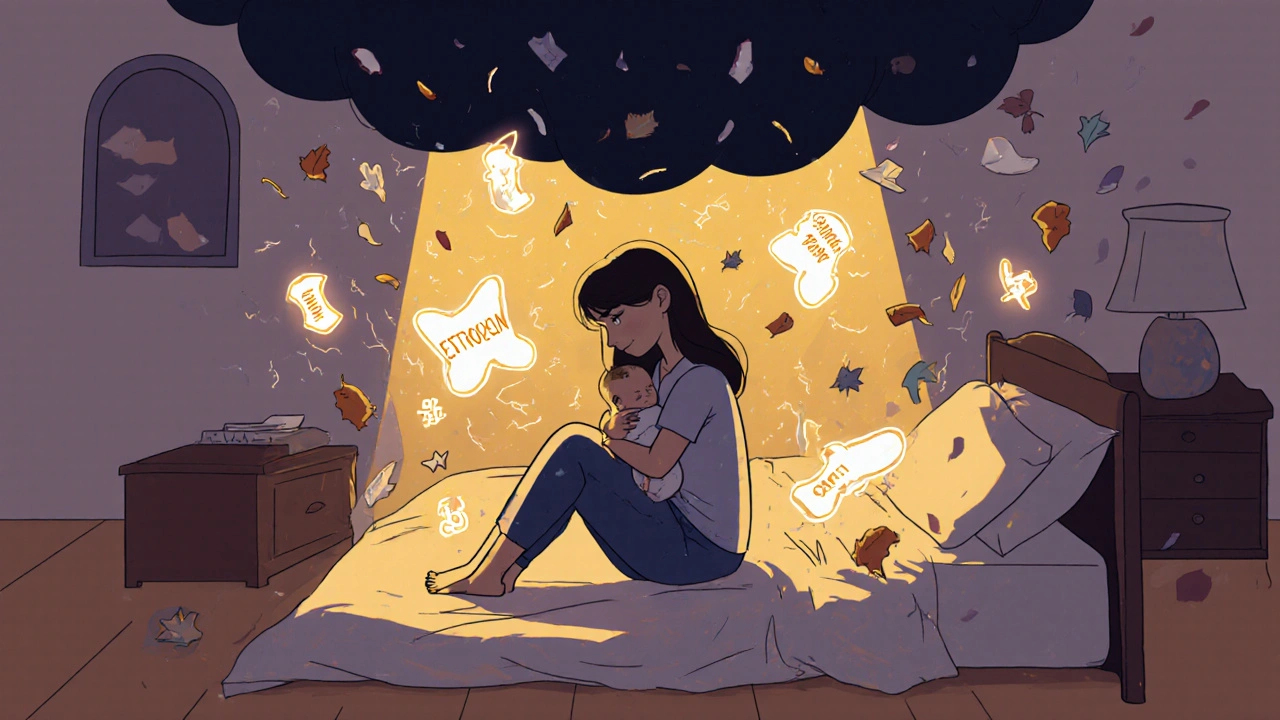One in seven new mothers experiences postpartum depression. That’s not rare. It’s not weakness. It’s a biological and emotional response to the massive changes happening inside the body after childbirth. Many assume it’s just the "baby blues"-that fleeting sadness that fades in a few days. But postpartum depression (PPD) is different. It lingers. It drains energy, steals joy, and makes bonding with your baby feel impossible. And it’s not just about hormones.
What’s Really Happening Inside Your Body After Birth?
Right after delivery, estrogen and progesterone levels-levels that soared tenfold during pregnancy-plummet. Within 48 to 72 hours, they drop back to pre-pregnancy levels. That’s a hormonal earthquake. For most women, the body adjusts. But for others, this sudden shift triggers a cascade of effects in the brain.
One key player is allopregnanolone, a metabolite of progesterone that helps calm the nervous system. When progesterone crashes, so does allopregnanolone. This can leave women feeling on edge, irritable, or emotionally raw-even if they’ve never struggled with anxiety or depression before. Studies also show that oxytocin, the bonding hormone released during breastfeeding, tends to be lower in women who develop PPD. Less oxytocin doesn’t just mean less connection to the baby-it’s linked to higher levels of depression and anxiety at eight weeks postpartum.
But here’s the twist: not every woman with extreme hormone drops gets PPD. And some women with PPD have hormone levels that look completely normal. That’s why experts now see hormones as just one piece of a much bigger puzzle. The brain doesn’t react to hormones in isolation. It responds to stress, sleep loss, trauma, social support, and even genetics all at once.
It’s Not Just Hormones-The Full Picture
Postpartum depression doesn’t pick its victims based on how high their estrogen was. It picks them based on vulnerability. A history of depression-even if it was years ago-doubles the risk. So does a lack of support. If you’re isolated, exhausted, or in a strained relationship, your brain is under constant stress. That stress raises cortisol, the body’s main stress hormone. Women with PPD often have higher cortisol levels that don’t settle down like they should.
Thyroid function can also dip after birth, leading to fatigue, weight gain, and low mood-all symptoms that look a lot like depression. And it’s not just mothers. About 1 in 10 new fathers experience postpartum depression, often triggered by sleep deprivation, financial stress, or feeling shut out of the parenting dynamic. Transgender and nonbinary parents also experience PPD at similar rates to cisgender women. Adoptive parents? Their rates are 6-8%. This isn’t a "mom thing." It’s a human thing.
Demographics matter too. CDC data from 2021 shows American Indian and Alaska Native mothers have a PPD rate of over 20%, nearly double that of non-Hispanic white mothers. Poverty, discrimination, lack of access to care, and historical trauma all play roles. PPD doesn’t care about your income level, but the system often does.
What Treatments Actually Work?
There’s no single cure for PPD-but there are several proven paths forward. The most common and effective are talk therapy and medication. Cognitive behavioral therapy (CBT) helps reframe negative thoughts and build coping skills. A 2020 meta-analysis found CBT led to remission in over half of women with PPD, compared to just over 30% in those who didn’t get therapy.
When medication is needed, SSRIs like sertraline are often the first choice. Why? Because they’re safe during breastfeeding. Hale’s Medication and Mothers’ Milk rates sertraline as L2-"safer"-meaning only tiny amounts pass into breast milk. Other SSRIs like fluoxetine are also used, but sertraline has the strongest track record for new mothers.
For women with moderate to severe PPD who haven’t responded to other treatments, there are newer options. In 2019, the FDA approved brexanolone (Zulresso), an IV infusion of allopregnanolone. It works fast-many women feel better within days. But it requires 60 hours of hospital monitoring because it can cause extreme drowsiness. In 2023, zuranolone (Zurzuvae) became the first oral version of the same drug. It’s taken for two weeks, at home, and doesn’t require constant supervision. This is a game-changer.
Transcranial magnetic stimulation (TMS) is another option. It uses magnetic pulses to stimulate underactive brain regions linked to mood. A 2020 study showed a 68% response rate in PPD patients after six weeks of treatment. It’s non-invasive, doesn’t affect breastfeeding, and is gaining traction in clinics across North America.

What Doesn’t Work (and Why)
Some people still believe PPD can be fixed with hormones alone. That’s a myth. While estrogen patches or progesterone supplements sound logical, they’re not proven. An early 2001 study showed high-dose estrogen helped 82% of women-but it was small, uncontrolled, and carried serious risks like blood clots and reduced milk supply. Hormonal treatments are still experimental. The American College of Obstetricians and Gynecologists doesn’t recommend them outside of clinical trials.
And while rest, yoga, and herbal teas might help you feel calmer, they’re not enough for clinical depression. If you’re struggling to get out of bed, crying for no reason, or having thoughts of harming yourself or your baby-those are red flags. No amount of lavender oil will fix that. Professional help is not optional. It’s urgent.
Screening Is the First Step
Massachusetts became the first U.S. state to require PPD screening in 2012. Now, more states are following. The tool they use? The Edinburgh Postnatal Depression Scale. It’s simple: ten questions about mood, sleep, and coping. A score of 10 or higher means you need to talk to a provider. It’s not a diagnosis-but it’s a signal.
Yet, 78% of OB-GYNs say they don’t feel prepared to treat PPD. That’s why you can’t wait for your doctor to ask. If you’re feeling off after birth, say it out loud. Write it down. Bring the screening tool with you. You’re not being dramatic. You’re being smart.

Support Is Available-And It Works
You don’t have to do this alone. Postpartum Support International runs a warmline (1-800-944-4773) that connects callers with trained volunteers. In 2024, they handled over 25,000 calls. Eighty-seven percent of people who called said the support was "helpful" or "very helpful." Peer groups, online forums, and local mom circles can make a huge difference. Feeling seen reduces isolation-and isolation makes depression worse.
And if you’re a partner, family member, or friend: listen without fixing. Don’t say "just get some sleep" or "it’ll pass." Say: "I’m here. What do you need today?" Sometimes, that’s the only medicine that works.
Recovery Is Possible
PPD doesn’t define you. It doesn’t mean you’re a bad parent. It doesn’t mean you failed. It means your body and mind are reacting to an overwhelming change-and they need support to heal. With the right treatment, most women recover fully. Some feel better in weeks. Others take months. Either way, healing is possible. You’re not broken. You’re human. And help is waiting.
Is postpartum depression the same as the baby blues?
No. The baby blues are mild mood swings, tearfulness, or fatigue that start within a few days after birth and usually fade by two weeks. Postpartum depression is more intense, lasts longer-often for months-and interferes with daily life, like caring for your baby, eating, or sleeping. If symptoms last beyond two weeks or get worse, it’s not the baby blues.
Can I take antidepressants while breastfeeding?
Yes, many are safe. Sertraline is the most commonly prescribed because very little of it passes into breast milk. Other SSRIs like escitalopram and paroxetine are also considered low-risk. Always work with your doctor to choose the safest option for you and your baby. The benefits of treating depression usually outweigh the minimal risks of medication exposure through breast milk.
How long does postpartum depression last?
Without treatment, PPD can last for months or even years. With treatment, most people start to feel better within 4-8 weeks. Some notice improvements in just a few days with IV treatments like brexanolone. Recovery isn’t linear-you might have good days and bad days. But with consistent care, full recovery is common.
Can men get postpartum depression too?
Yes. About 1 in 10 new fathers experience postpartum depression. Hormonal shifts, sleep loss, financial stress, and feeling disconnected from the baby or partner can all contribute. Men are less likely to be screened or seek help, but the symptoms are similar: irritability, fatigue, withdrawal, and feelings of hopelessness. Support and treatment work just as well for fathers.
What should I do if I think I have PPD?
Reach out. Talk to your doctor, midwife, or a mental health provider. Use the Edinburgh Postnatal Depression Scale to track your symptoms. Call Postpartum Support International at 1-800-944-4773. Don’t wait until it gets worse. Early intervention leads to faster recovery. You don’t have to suffer in silence.
Are there any natural remedies for PPD?
Exercise, sunlight, good nutrition, and sleep can help improve mood-but they’re not enough on their own for clinical depression. Omega-3s, vitamin D, and magnesium may support brain health, but there’s no strong evidence they treat PPD. Never replace professional care with supplements. If you’re struggling, combine natural support with therapy or medication for the best results.
What’s Next?
If you’re recovering from PPD, keep going. Therapy doesn’t end when you feel better. Medication might be temporary. Support groups can become lifelines. And if you’re planning another pregnancy, talk to your provider ahead of time. Women with a history of PPD have a 30% chance of recurrence. With planning-screening, early therapy, and a solid support system-you can protect your mental health before it slips away again.
You didn’t cause this. You can’t control it alone. But you can heal-and you don’t have to do it by yourself.

Erika Sta. Maria
November 21, 2025 AT 10:06ok but have u ever considered that maybe the real issue isnt hormones but capitalism? like why are we putting the burden of emotional labor on women after birth? why is the system designed so that you're expected to bounce back while your body is literally falling apart? i mean, if you think PPD is just about allopregnanolone, you're missing the forest for the trees. we're talking about a world where maternity leave is a joke and your partner works 80-hour weeks. the hormone crash? that's just the cherry on top of the trauma sundae. #systemicfail
Debanjan Banerjee
November 22, 2025 AT 07:27There is a significant body of peer-reviewed literature supporting the neuroendocrine hypothesis of postpartum depression, particularly regarding allopregnanolone and GABA-A receptor modulation. However, it is equally critical to acknowledge the biopsychosocial model, which integrates psychosocial stressors, sleep deprivation, and socioeconomic determinants. The 2023 meta-analysis by Zuckerman et al. confirms that hormonal fluctuations alone account for approximately 34% of variance in PPD onset, with cortisol dysregulation and oxytocin deficits contributing substantially. Treatment protocols must therefore be multimodal.
Steve Harris
November 22, 2025 AT 19:52Just wanted to say thank you for writing this. I’ve been a nurse for 15 years and I’ve seen too many new moms suffer in silence because they were told it’s "just hormones" or "you should be happy." The fact that we now have oral allopregnanolone? That’s huge. My sister took Zurzuvae last year-started feeling like herself again by day 5. No hospital stay. No stigma. Just science helping people. If you’re reading this and you’re struggling-you’re not broken. You’re brave for even clicking on this post.
Darragh McNulty
November 24, 2025 AT 01:01THIS. 💔 I had PPD after my second and no one asked me how I was. My husband was working double shifts, my mom was in another country, and I felt like a ghost in my own life. The warmline saved me. 1-800-944-4773 is real. I cried talking to that volunteer. She didn’t fix anything… she just listened. 🫂
Paula Jane Butterfield
November 25, 2025 AT 23:57As a Black mom who almost lost it after my daughter was born, I want to say: the stats are real. I didn’t have a doula, my OB didn’t screen me, and my insurance wouldn’t cover therapy. I cried in the grocery store because I couldn’t afford organic food and my baby wouldn’t sleep. PPD doesn’t care if you’re educated or married-it cares if you’re supported. Please, if you’re a provider: screen everyone. Not just the ones who look "sad."
Simone Wood
November 26, 2025 AT 10:11OMG I’m so glad someone finally said it-this isn’t just about women. My brother had PPD after his wife gave birth. He started drinking, stopped talking to his kids, and slept 14 hours a day. No one asked him if he was okay. He’s a man. He’s supposed to be "strong." But he cried in my car for an hour last week and said, "I didn’t know I could feel this empty." We need to stop gendering mental health. It’s not a mom problem. It’s a human problem.
Swati Jain
November 28, 2025 AT 07:46let me guess-next they’ll tell us that yoga and turmeric lattes cure clinical depression? 😂 i mean, seriously? you think a 20-minute meditation will fix the neural rewiring caused by 3 months of sleep deprivation, financial panic, and a partner who thinks "helping" means holding the baby while scrolling TikTok? please. if you’re not on SSRIs or in CBT, you’re just decorating your despair. #realtalk
Florian Moser
November 29, 2025 AT 15:12Reading this made me cry. Not because I’ve had PPD-but because I’ve seen it. My cousin didn’t get help for 8 months because she thought she "should be grateful." She wasn’t weak. She was exhausted. And now? She’s in therapy, on sertraline, and breastfeeding like a champ. Recovery isn’t about being perfect. It’s about being heard. You’re not alone. Seriously.
jim cerqua
November 30, 2025 AT 18:40Let’s be brutally honest: this whole PPD narrative is being weaponized by Big Pharma. Brexanolone costs $34,000. Zurzuvae? $20K. And guess who’s pushing it? The same companies that made billions off antidepressants in the 90s. Meanwhile, the real solution-paid parental leave, universal childcare, mental health parity-is ignored. They want you to pop a pill instead of demanding systemic change. Hormones? Sure. But the real poison is the system that lets mothers fall through the cracks.